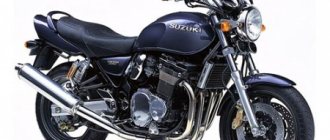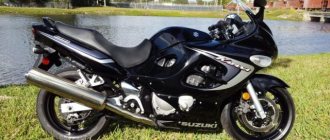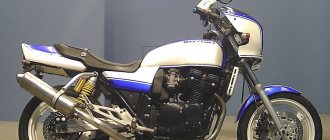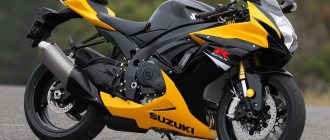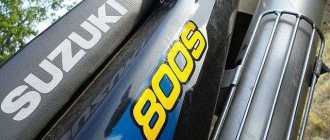Description
The classic road bike Suzuki GSX 400 Inazuma model appeared on the market in 1997 and was only available for the domestic Japanese market. Since 1998, the older models of the Inazuma line have appeared on the market - Suzuki GSX750 Inazuma and Suzuki GSX1200 Inazuma. Despite the fact that the Inazuma 400 officially appeared before these models, it was built on their basis - in particular, the reduced-volume engine with gearbox was taken from the Inazuma 750, and the frame and chassis were taken from the Inazuma 1200.
The engine of the Suzuki GSX400 Inazuma is an in-line 4-cylinder air/oil cooled unit with a displacement of 399 cm³, producing a standard 53 hp. power and 36 Nm of torque. The motor is high-speed, with maximum performance at 9500-11000 rpm. This engine was built on the basis of the Inazuma 750 engine, which, in turn, came from the Suzuki GSX-R750 sports model.
Among the features of the Suzuki Inazuma 400, one should highlight its rather rich equipment - KYB rear suspension and 4-piston Brembo front brakes. All this has been transferred unchanged from the older version of the Suzuki GSX1200 Inazuma.
2001 was the last year of production of the model, after which it finally left the market. It so happened that the model existed for only 2 years - in 1997 and 2001. The 2001 models were updated to meet new environmental requirements, receiving a catalyst and carburetors with throttle position sensors.
Shock absorption system
It's hard to imagine a classic street motorcycle without a well-functioning suspension system. To eliminate various vibrations as much as possible and confidently overcome holes and potholes, the brand’s engineers have done a tremendous job. Thus, as a result of the work, a telescopic fork was provided at the front. At the rear there is a double spring shock absorber. Considering the fact that the motorcycle is designed for riding on normal road surfaces, the Inazuma 400 is still capable of short off-road trips.
Specifications
| Model | Suzuki GSX400 Inazuma |
| Motorcycle type | road (street, classic) |
| Year of issue | 1997-2001 |
| Frame | steel tubular |
| engine's type | 4-cylinder, 4-stroke, in-line |
| Working volume | 399 cm³ |
| Bore/Stroke | 52.0 x 47.0 mm |
| Compression ratio | 11.2:1 |
| Cooling | air-oil |
| Number of valves per cylinder | DOHC, 4 valves per cylinder |
| Fuel supply system | Carburetor, 4x Keihin CVK30 – Inazuma 400 (1997) Carburetor, 4x Keihin CVR28 – Inazuma 400 (2001) |
| Ignition type | transistor |
| Maximum power | 53.0 hp (39.0 kW) at 11000 rpm - Inazuma 400 (1997) 52.0 hp (38.0 kW) at 11000 rpm – Inazuma 400 (2001) |
| Maximum torque | 36.0 Nm (3.7 kg*m) at 9500 rpm |
| Transmission | 6-speed |
| type of drive | chain |
| Front tire size | 120/70-ZR17 (58W) |
| Rear tire size | 170/60-ZR17 (72W) |
| Front brakes | 2 discs, 310 mm, 4-piston calipers |
| Rear brakes | 1 disc, 240 mm, 2-piston caliper |
| Front suspension | 43 mm telescopic fork (non-adjustable), travel - 130 mm |
| Rear suspension | pendulum with two shock absorbers (preload adjustment), stroke - 120 mm |
| Motorcycle length | 2140 mm |
| Motorcycle width | 745 mm |
| Motorcycle height | 1090 mm |
| Wheelbase | 1460 mm |
| Seat height | 760 mm |
| Minimum ground clearance (clearance) | 125 mm |
| Acceleration to 100 km/h | 5.5 sec |
| Maximum speed | 180 km/h |
| Gas tank capacity | 18.0 l |
| Motorcycle weight (dry) | 185 kg – Inazuma 400 (1997) 187 kg – Inazuma 400 (2001) |
Review of the Suzuki Inazuma 400 (GSX 400) motorcycle
The actual ride quality and driving experience. Well, of course, to a beginner, the hurricane power of a 400 cc Japanese motorcycle, albeit 15 years old, seems like a hurricane, but in fact, behind the first explosion of delight, shortcomings are also visible, but first things first. The motorcycle has been well preserved, showing a mileage of 21+ thousand kilometers, and started up well after replacing the old spark plugs. It really doesn’t like to start when it’s cold; you have to run it with the starter for a long time (all starts must be carried out with the fuel enrichment lever pulled out—the “choke”). The pleasant, not “crazy” sound of the engine’s operation attracts passers-by and neighbors.
The gearbox does not cause any complaints: the shifts are clear and understandable, neutral is caught without difficulty, even with your eyes closed, of course, after some experience in owning a motorcycle. When driving, unfortunately, there are also disadvantages: when driving in city traffic, driving in second is possible up to a maximum of 30 km/h, then the speed rises and the motorcycle starts to work very noisily - as a result, third gear, and then you have to brake, again in 2 pull up, stop, 1 again, etc. In general, not a V-twin, there is little traction at the bottom, but this is already a specificity rather than a disadvantage. gears 2,3,4 are very dynamic, the motorcycle accelerates powerfully, 5th gear is more likely to slow down and maintain speed.
Yes, yes - now about speed and riding:) I personally accelerated the motorcycle to 150 km/h in fourth gear, with a decent reserve of power and throttle travel; which indicates the possibility of reaching its maximum speed (according to the speedometer and limiter) of 180 km/h. But driving at speeds over 100 is no longer enjoyable. If you don’t have special motorcycle equipment, then a comfortable speed is 70-80 km/h, with gear - 120. The lack of a windshield or glass does not allow you to ride at high speed for a long time. The engine is revvy (cut down a little, but still very sporty from the GSX-R 400), and maximum power feels around 8-9 thousand rpm. The motorcycle can shoot, but its shock absorption and appearance are not at all conducive to this.
Suspension and damping: a too soft front fork (a national feature of the Japanese) interferes with comfortable and precise cornering (well, installing stiffer springs should solve the problem), changing the oil to a thicker one did not lead to anything. The same soft rear shock absorption, matching the front (by the way, there are two shock absorbers, versus one for the bandit) when turning gives the feeling of a “herring” swaying on the waves. Of course, all this can be solved by investing money in replacing old shock absorbers with hard ones, but this is a very expensive pleasure and, as a result, an unnecessary luxury on a budget motorcycle.
Look and feel. The motorcycle looks very interesting - only owners of Russian motorcycles and hardcore motorcyclists who are tired of modern pathos will understand the retro style. Strangely enough, he primarily attracts the attention of men (!), but girls look at him indifferently. Therefore, a motorcycle is not suitable for young people who want to attract attention. The color of my motorcycle is silver-gray; overall it doesn’t stand out in any way, but this is a plus for balanced people. The feeling of riding a motorcycle is like riding some kind of cruiser: the shiny edges of the dashboard shine and shimmer in the sun, leisurely movement in the city, this masterpiece of the motorcycle industry is demonstrated to the public and arouses their genuine interest.
The seating position is as expected on a road, everyday motorcycle - comfortable and not straining, except that for some reason the rear brake lever causes problems - the leg is very strained due to its bending with the toe forward. Apparently the motorcycle is not designed for tall people, although I’m not one of them (164 cm). Obviously: the pegs are too high, which on the other hand is a plus - the motorcycle can be leaned into a turn more strongly, which does not really fit with the “cotton” suspension - this minus. I can’t say anything about the passenger’s comfort - I haven’t had to transport anyone yet, but observing from the side the position of the tall passenger’s legs on the driver’s elbows makes me doubt it.
The average consumption in a mixed cycle (city-suburb) is 4.5-5.5 liters of 92 grade gasoline. The fuel tank holds 19 liters.
To summarize: This is a very well balanced motorcycle in terms of comfort and dynamics, but loses in handling. Relatively low cost is combined with good performance and high quality.
A good motorcycle for learning and starting a motorcycle life.
I rode my first season on the Inazuma 400. Quite a fast motorcycle. And so a road worker is like a road worker. It has another big plus - the seat is just a sofa - large and comfortable. On long trips this is very noticeable. I received the motorcycle a little shaky, I had to use my hands to fix it. But any maintenance technique requires this. Depends on the initial state. Basically everything was limited to replacing consumables. Access to all components is easy if you have a center stand (I don't have one). In my opinion, the air-cooled engine is only a plus - it is less complex, there is less chance of a malfunction due to an oversight at the very beginning. In the Vladivostok traffic jams it never overheated once all summer. The motorcycle handles well - I got used to it quickly, and by the middle of the season, already in some turns my boot began to catch the asphalt. At low speeds it is more difficult, since the weight is large and the center of gravity is quite high, but it is also acceptable. Consumables... I found everything. Much comes from the bandit, almost everything (except for the cylinders, probably) from the European version of the GSX750Y. This is the same Inazuma. I also have a repair manual for it. The easiest way is to search by catalog numbers from Megazip or somewhere else. In short, I really like the motorcycle. I will only change to Africa. But not next season, that's for sure.
The low price can be explained by the simple design, unpopularity of the model in Russia and great popularity in Japan. I didn’t encounter any so-called pitfalls. An excellent Japanese motorcycle, reliable like everything Japanese. But of course it all depends on the condition of the particular instance.
It’s convenient to go to the valley if you don’t go into shit - this is definitely not an enduro. Although I ride on gravel roads slowly. In general, it all depends on your skills.
There are no problems with the fork at all (pah-pah-pah). I don’t even know what kind of oil was poured in, it hasn’t changed since Japan. My gasoline consumption is from 5 to 7 liters per 100 km. Depends on how you turn it and what quality of gasoline it is. Over the winter I am going to radically clean the air-fuel system, I think the consumption should decrease. In May I filled up the oil with Liquai Molly 10W40 semi-synthetic, and during the season and about 7000 km I didn’t eat a drop.
Manual in English with detailed pictures (weighs 67MB). I do everything according to it myself until everything matches. If you need it, I can use it for soap. And the Inazuma really looks much more interesting than the truck. More about long trips. I installed a front fairing for myself, now it’s absolutely beautiful - it doesn’t blow away at high speeds, the ride has become more comfortable, you get less tired. Sometimes I spent 16 hours a day on the road (I didn’t ride all the time, of course), and my spine didn’t fall into my pants, and my butt didn’t hurt, and my arms didn’t fall off... In general, I may not be completely objective, since on other motorcycles I I only managed to ride. But overall, I have no complaints about the motorcycle as a road bike.
I started with this myself. The transition period after the Soviet motorcycle industry ended with a general meeting of already experienced bikers, at which it was decided to start riding a more modern motorcycle. The meeting decided to look for a motorcycle with a 400 cc engine. They still said that you would sell it in half a year. I got it in good condition, although the speedometer shows 8000 miles, which is really not true.
At first he seemed like a rocket, but after a few months he realized that everything his friends said was true. I got used to motorcycles and realized that modern motorcycles are far from the Soviet era. Now the motorcycle has been sold and bought with a larger capacity - I don’t understand those guys who just get their license and immediately jump on liter motorcycles.
The wheelbase of the motorcycle is not long and it is pleasant to steer in traffic jams. The first gear is short, there is no wanking clutch - gas again through the same traffic jams. You can drive at idle.
The front fork is weak, sometimes it bounces all the way downhill, the Kulibins suggested installing stiffer springs, but I didn’t bother - I knew I’d sell it.
The engine starts revving only from 9000 rpm. Once I accelerated to 170 - chatting on the road, experiments with speed are over. Moreover, there was a pro-sport exhaust; the previous owner removed the original one and installed a tuned one. The sound is pleasant and at high speeds even fire flew out, but this is in the city... but on the highway more than 120 km the ears simply fall off. When choosing, look at the muffler and listen to the sound at speed; in addition to clogged ears, you will also have to prove your case at the technical inspection, which is very troublesome.
When I found another moto, my friend and I drove 300 km to another city, it was not comfortable to sit in the back, my legs bent too much at the knees, I had to stop and shake my legs and ears. I didn’t waste the oil at all, and the gas mileage was pleasantly surprising. Now I only have time to fill 850 cubic meters.
What I want to say is that the motorcycle is cool in its own way and is very suitable for beginners. In our city, a couple of girls race on these - the bike doesn’t weigh much, apparently they can handle it. Good for getting around the city. With my height of 187, it’s not very comfortable to ride, and it doesn’t look very good from the outside. Well, again regarding gasoline - it is very economical, if you are happy with all the pros and cons, take it. Moreover, the price tag is quite tasty.
